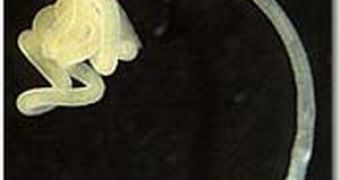Researchers discovered a unique lifestyle of a gutless worm living through marine sediments and hosting a community of symbiotic microbes under its skin, with no need for digestive and excretory systems.
The worm has no mouth, anus, guts, renal system.
The worm is a marine oligochaete isolated off of the coast of Elba island (the Mediterranean Sea).
A team from the U.S. Department of Energy's Joint Genome Institute (DOE JGI) has studied this complex worm/microbe relationship by DNA sequencing and other diagnostic techniques.
This species was named Olavius algarvensis and has no mouth, relying on its bacterial tenants.
In the symbiosis, the worm transports the bacteria to optimal energy sources moving slowly between the upper oxygen-rich and the lower oxygen-depleted coastal sediments.
In exchange, organic nutrients and vitamins are synthesized by the subcuticular communities of symbionts.
Toxic waste products of protein metabolism like ammonium and urea are recycled by these symbionts, leaving the host with no need of an excretory system but also conserving valuable nitrogen, further maintaining the microbial community.
"It's an excellent example of outsourcing energy and waste management, where this worm and the microbes living under its skin are enjoying a mutually beneficial relationship," said Eddy Rubin, DOE JGI Director.
"The microbes, floating around in the sea, strike up a bargain with the worm-in exchange for housing, the microbes take care of energy production and handling the waste," Rubin said.
The microbial community of the worm was studied for the first time through metagenomics, a strategy pioneered by DOE JGI and its collaborators.
This means isolating, sequencing, and characterizing DNA extracted directly from environmental samples, in order to obtain a profile of the microbial species in an environment.
The worms and their microbial community cannot be grown in the laboratory.
Unusual about this symbiosis was that several different microbes are involved, unlike most symbiotic interactions between larger organisms and microbes where usually, only one microbial species is present.
A total of 204 million bases (units of genetic code) were generated.
Through a process known as "binning", these sequences were then organized by specific DNA signatures to identify the microbial species.
"By sequencing the genomes of the microbes we were able to discern how they cope with the needs of the worm and why such a diversity of microbes is warranted," Rubin said.
The worm copes also with the transportation of the bacteria.
The worm heads through sediments for different environments, each with different chemical constituents, which provides energy adapted to the adaptations of a particular group of microbes.
The microbes use chemical energy from the sediment to convert organic material into the stuff that nourishes the worm. As the worm doesn't have a mouth, sediments pass through the skin.
"It's not unlike a car with a hybrid motor that can run on both electricity and gas depending on the situation," Rubin said.
"In certain places the worm is powered by specific bacteria that can exploit the chemical energy abundant at a specific location, while in other strata, where a different chemical energy source is abundant, the worm switches its energy production to resident bacteria that can exploit that available energy source."
"We have been dependent on fossil fuels. In the future we need to adapt like this worm has and use a variety of different energy sources to ensure our needs can be met in a changing world."

 14 DAY TRIAL //
14 DAY TRIAL //